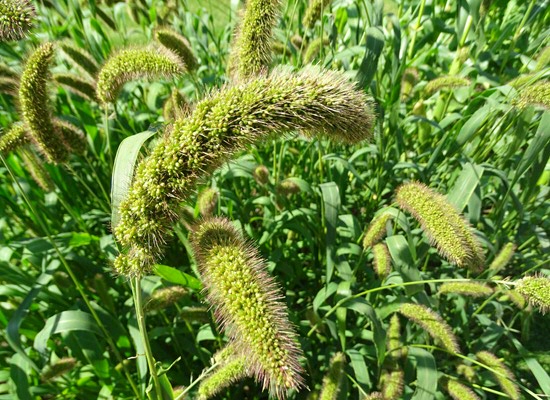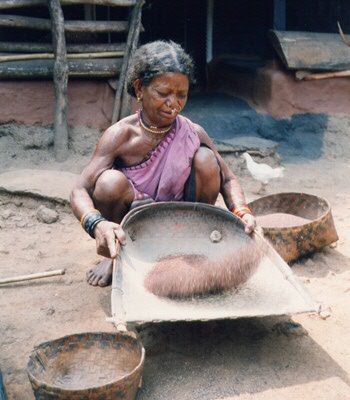Millets: ancient crops for the future

Hunger, dehydration, impoverishment. It doesn't take a prophet of doom to predict this as the future scenario for certain parts of the world. Millets might just be the solution. There is a good reason for the UN dubbing 2023 the International Year of Millets. UG researchers René Cappers and Peter Berger are trying to find out what is needed to promote the cultivation of these crops in India.
Text: Gert Gritter, Communication UG
Not sexy
The majority of the Western population has never eaten millets. They are not particularly sexy crops. Strange really, because they taste fine, are easy to digest, gluten-free and simple to cook (like rice, but a shorter cooking time). They seem to have an image problem. The low status is largely because it’s seen as a food for poor people. For many years, millets have quite literally lost ground to other varieties of grain.
Not much water or fertilizer
This is a great pity as the about ten different species of grain collectively known as millets are ideal for dry, barren soil, where less robust alternative grains are unable to thrive. Millets don’t need much water or artificial fertilizer and can withstand hot and cold conditions. This is why the Groningen-based researchers Berger and Cappers have applied to the Dutch Research Council (NWO) for funding. In collaboration with colleagues from Frankfurt, they hope to understand the rise and fall of millet cultivation in the past and similar dynamics in the present.

Stereo research
Berger and Cappers come from different branches of academia, which makes them a highly suitable team. Berger is a cultural anthropologist, while Cappers is an archaeo-botanist. Whereas Berger has a synchronous focus on the people behind the crop (what the current situation is), Cappers’ primary focus on the crop behind the people is diachronous (how the situation has developed over the years). There’s a funny story about how they met. Berger was in London for an expert meeting, and was explaining that he was exploring the possibilities of millet. Suddenly, the host cried out: ‘You must know René Cappers then!’ They had never heard of each other and knew nothing about each other’s research, even though they only worked a few hundred metres apart.
Partners in crime
Berger and Cappers have something important in common; they are both multi-disciplinarians. Cappers combines his background as a botanist with archaeological research. He is interested in finding out which crops people have cultivated at various times and in various places, including food crops. The main focus of his work is on the development and distribution of farming in North-West Europe, as well as in the Near East and Sub-Saharan Africa. He now has an impressive collection of seeds and other plant material at his disposal. His partner in crime Berger is a social-cultural anthropologist, who works in the Faculty of Theology and Religious Studies. Berger is mainly interested in the way that people interact with food, along with rituals, cosmology and cultural-religious change.

Highland people
Berger is involved in a long-term ethnographic study taking place in Odisha state, on the eastern coast of India. He is studying the tribal societies of the Adivasis. As they usually live in the remote higher reaches of India, they are commonly known as ‘highland people’. Berger: ‘They are a marginalized ethnic minority in India, accounting for some 8% of the population. The word ‘‘minority’’ normally implies a small group of people, but everything is relative on a sub-continent with a population of over one billion. This is a highly diverse group of around 100 million people, widely dispersed across the country, and all with their own languages, cultures and religions. Berger spent two years living among the Adivasis in Odisha, learning their language and studying them first hand. He and Cappers are conducting their joint research in this same area.
Millet as children
Cappers and Berger hope that their research will allow them to make recommendations to the Indian government and NGOs about both policy and communication. Cappers: ‘We don’t just want to understand the dynamics behind the choice of food, but also the consequences of intervening in agriculture. In the past, the higher echelons encouraged the people to grow rice and wheat, in the interests of food security and India’s green revolution. But rice farming can have dire consequences for the environment and the landscape, because it requires so much water, for example. A knock-on effect is that culture and society suffer too. The key question is how to ensure that agriculture is sustainable in the long term.’ Berger adds: ‘The cultural dimension is especially important. It is a paradox that millets are now regarded as crop for the future, while de Adivasi are still considered by many lowlanders to be some kind of primitive stone age people. The animistic Adivasis see grains as non-human people, for example. They think and talk about millet as children and rice as bride. So it’s not just about increasing the yield, the nutritional value and filling stomachs.’
Future expectations
What do the researchers think about millet themselves? Cappers is very down-to-earth and prefers ‘ordinary’ food. But Berger ate it quite often while he was living in Odisha and learned to appreciate it: ‘They make a slightly fermented, very creamy, tasty gruel from it. People who work long days outside in the heat drink it twice a day. It provides them with energy and they don’t need to eat anything else then. They were amazed when they saw me drinking bottles of water all day long.’ Finally: what do they expect from millet as a grain in the future? Wearing his biologist’s hat, Cappers tends to think like a scientist. He can see the benefits of millet and various potential uses. Berger is more cautious as an anthropologist: ‘I’m afraid that the Indian government will opt for a top-down approach. Solutions will only succeed if you take the local population into account. It’s not a question of one size fits all…’
More information
- Peter Berger
- René Cappers
More news
-
16 December 2025
How AI can help people with language impairments find their speech
-
18 November 2025
What about the wife beater? How language reinforces harmful ideas
-
03 November 2025
Menopause in perspective: How the media influences our perception
